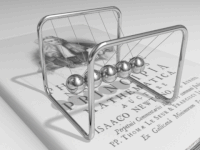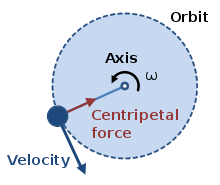OK, momentum is not a force.
impulse is not a force either.
the only thing that is a force is a force of course.
so after each 100 kg mass has been accelerated for 1000 meters at a rate of acceleration of .8 m/s/s and has reached a velocity of 40 m/s during a time of 50 seconds.
the following is true after each mass has traveled 1000 meters just before it enters the turn.
each 100 kg mass has a momentum of
p=mv
-4000 Ns = 100 kg x -40 m/s
and
each 100 kg mass has a force that it can apply to an object of
f=ma
-80N=100 kg x -.8 m/s/s
because momentum is not a force it cannot push an object.
so the only force that can push against the pipe in the (-)
direction is the force that is the product of the 100 kg mass
times its acceleration.
which is -80N
correct?
the 100 kg mass has an acceleration of 0.8 m/s/s
if we only use the mass x the rate of acceleration of the mass to calculate the impact force of the collision we get
f=ma
force N = 100 kg x 0.8 m/s/s
80N
That's correct, as long as it's accelerating at 0.8m/s^2 _during the collision_. However it's not necessarily doing that in our pipe.
as long as it's accelerating at 0.8m/s^2 _during the collision
as the mass passes through the turn at 40 m/s it undergoes a constant acceleration , it maintains this constant acceleration through the turn because it maintains a constant angular velocity.
the reason it maintains a constant acceleration is because it must be accelerated towards the center of the turn as it passes through the turn , this acceleration is called angular acceleration.
The product of a mass and a velocity is not a force!How many times do I have to tell you that acceleration is not the same a velocity?that would be a force of 40N.sArarrh13!#@ Force does not have units of Ns!!!! That's momentum. What is an easy way for second graders to understand the conceptual difference between momentum and force. Replies:
Force makes momentum change. Mathematically,
the force on an object is equal to the rate at which the object's momentum changes. Tim Mooney
Not an easy concept to convey to students especially at young age. You might try the following analogy: Acceleration is the rate of change (time) of velocity. This is simple to explain using the concept of acceleration in an automobile. Analogously,
force is the rate of change of momentum.
Harold Myron
Force is how hard you push or pull on an object.
Momentum relates more to how hard it is to stop an object from moving. A 10mph bowling ball is much more difficult to stop than a 10mph ping-pong ball. The bowling ball has more momentum.
Momentum is within an object, carried with the object.
Force is between objects.
Momentum is like what the object has in its bank account. Force is like giving some of this momentum to another object every second they are in contact. I use "bank account" rather than "wallet" because a bank account balance can be negative. It allows momentum to have direction.
Kenneth Mellendorf
since the 100 kg mass does not loose any of its velocity as it travels through the turn then it hasnt given any of its momentum to the pipe.
because it still has its mass and it has 40 m/s velocity
only in a new direction.
but mostly because its momentum cannot push the pipe with force because momentum is not a force.
p=mv
+4000Ns = 100 kg x +40 m/s
all it has done is gone through a turn.
the only force that could cause the pipe to reduce its acceleration is the force available from the 100 kg mass.
and the 100 kg mass only has a -80N force as it enters the turn and collides with the pipe
however there are 100 masses supplying a +80N force to the pipe while they are accelerating and decelerating durring the 1 second that the 100 kg mass is applying its -80N force.
thats +8000N vs -80N

there will be a force felt by the turn as the mass passes through the turn and that force is the centripetal force
which is a force that is directed towards the center of the turn.
Centripetal force (from Latin centrum "center" and petere "to seek") is a force that makes a body follow a curved path
fc=mv^2/r
the radius of the turn is 12.73 meters
fc = 100 kg x (40 m/s * 40 m/s)/r
fc = 100 kg x 1600 / r
fc = 160000 /12.73
fc = 12568N
but that force is not an outward force that would cause the
pipe to decelerate.
then there is the fictitious centrifugal force that is supposed to be an outward force.
however since it is a fictitious force we will not concern ourselves with it.
there is one thing to consider also , as the mass passes through the middle of the turn its velocity is directed at a 90 degree angle from the center of the turn as in the below illustration.

so as the mass passes through any part of the turn the -80N force that it can use to push the pipe with in the (-) direction is always at a 90 degree angle to the center of the turn and only momentarily toward the (-) direction as it first enters the turn.
the mass that is passing through the turn is undergoing centripetal acceleration , this acceleration is toward the center of the turn , not away from the center of the turn.
ac = (v^2)/r
ac = (40 m/s x 40 m/s)/12.73
ac = 125.678 m/s/s
the mass accelerating towards the center of the turn at a acceleration of 125.678 m/s/s times it mass = its force.
f=ma
f=100 kg x 125.679 m/s/s = 12567.8N
seems that that was the centripetal force ?
yes , it was..
here it is again.
fc=mv^2/r
fc = 100 kg x (40 m/s * 40 m/s)/r
fc = 100 kg x 1600 / r
fc = 160000 /12.73
fc = 12568N
and all thats left is friction.





